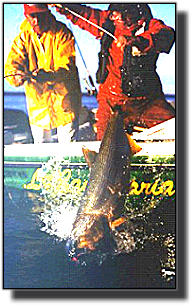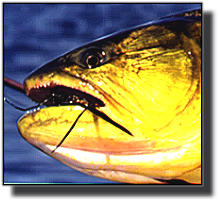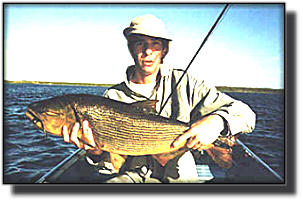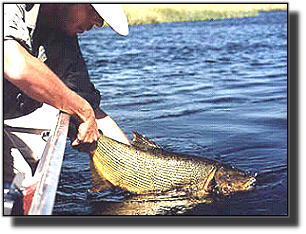

|
Dorados in Argentina
By Alejandro Martello
Photos by Mariano Moran and Alejandro Bianchetti


|
By Alejandro Martello
Photos by Mariano Moran and Alejandro Bianchetti
 Dorado (whose scientific name is Salminus Maxillosus) or the
Tiger of the Rivers, has an extraordinary sportive value for the
struggle offered to fishermen trying to catch one.
Dorado (whose scientific name is Salminus Maxillosus) or the
Tiger of the Rivers, has an extraordinary sportive value for the
struggle offered to fishermen trying to catch one.
|
 Dorado is a big fresh water fish that can weight up to 70 lbs. But
the common sizes are in the 13 lbs. to 35 lbs. range. The photo at
the top of this article also shows a thirty-three pounder.
Dorado is a big fresh water fish that can weight up to 70 lbs. But
the common sizes are in the 13 lbs. to 35 lbs. range. The photo at
the top of this article also shows a thirty-three pounder. |

|
|
It´s a very powerful fish, a 15 pounder peels off fifty yards of backing
in just one rush, after that high jumps and other rushes complete the fight.
|
|
Dorado is a great hunter who chases small to medium size fish in deep
fast moving riffles. If the dorado is feeding, you can see smaller fish
jumping out of water trying to escape from it´s huge, big teeth mouth.

|
|
If you want a big one you have to concentrate on mouth of lagoons
openings where water is either coming in or pouring out depending upon river levels.
The dorado is hidden near this location to feast on baitfish caught in the current.
|
 Dorado fishing is one of the most attractive and fascinating fly fishing
sports you can practice in Argentina. It´s mainly practiced in Mesopotamia,
between January and October. The biggest activity is on the Paraná River,
from Misiones state to De La Plata river. You can also fish dorados in the
Honde River, Uruguay, Bermejo, Pilcomayo and Paraguay rivers
and their tributaries.
Dorado fishing is one of the most attractive and fascinating fly fishing
sports you can practice in Argentina. It´s mainly practiced in Mesopotamia,
between January and October. The biggest activity is on the Paraná River,
from Misiones state to De La Plata river. You can also fish dorados in the
Honde River, Uruguay, Bermejo, Pilcomayo and Paraguay rivers
and their tributaries.
|
Tackle and technique

Dorados eat a great variety of baitfish so we must have a complete fly
selection that imitate those small fish. Many of these flies must have a
lot of flashabou, krystal flash or tinsel, because the dorado loves sparkling flies.
|
 Dorado flies offer big wind resistence, so you have to use it with a 7, 8
or 9 wt. rod, the only one that can handle a big dorado fight.
Dorado flies offer big wind resistence, so you have to use it with a 7, 8
or 9 wt. rod, the only one that can handle a big dorado fight.If you want a fly not too heavy, you must choose materials such as deer, rooster feathers and reflective materials.
|
 Bright and light coloured flies work well in high light conditions
and dark flies work well in low light conditions.
Bright and light coloured flies work well in high light conditions
and dark flies work well in low light conditions. |
 Flies must be tied on a big, strong hook, the same you use
on saltwater flies or on bass flies.
Flies must be tied on a big, strong hook, the same you use
on saltwater flies or on bass flies.You can use medium to big size surface poppers. They´re common in lagoons and marshs where water is low and clear.
In still water, popper works like an attractor and dorado can hear it from long distance and in deep waters.
|
 But streamers are the way to catch a big one. The most
common patterns are from salt water flies like Lefty´s Deceiver,
with many variations like muddler heads, dumbell and chain
eyes and a lot of flashabou and krystal flash.
But streamers are the way to catch a big one. The most
common patterns are from salt water flies like Lefty´s Deceiver,
with many variations like muddler heads, dumbell and chain
eyes and a lot of flashabou and krystal flash.The best color for streamers are black and combinations like purple/black, black/white, black/yellow/white, red/white, green/ white. In a typical fishing day, dorado feed near the surface so you have to use floating or sinking tips lines, later you can change to a shooting taper IV or VI sinking rate.
 And when everything works, you catch fish! ~ Alejandro Martello |
[ HOME ]
[ Search ] [ Contact FAOL ] [ Media Kit ]